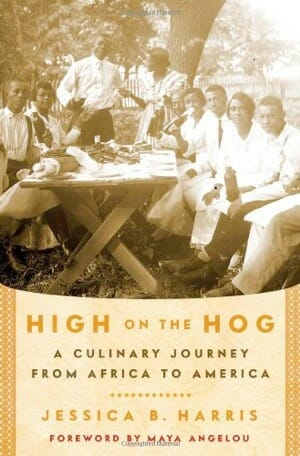High on the Hog: A Culinary Journey from Africa to America by Jessica B. Harris
Books Reviews America
As Americans, certain foods stand out to us and our well-trained pallets as ‘American Cuisine.’ Standard, everyday hamburgers. Chicago Dogs with their neon green relish and strict no-ketchup rule. In New York, the pizza’s signature burn-the-roof-of-your-mouth mozzarella. Though inherently American, such classics enjoy their own colorful and ingenious pasts. Like people, our foods are immigrants.
The Vienna Beef hot dog, required in all dogs that wish to bear the Chicago stamp of approval, came from the fertile minds and grinders of two Austria-Hungarian immigrants just in time for the world’s fair in 1893. Gennaro Lombardi, an Italian immigrant, had the wit to let an employee of his grocery store start tossing pizzas to sell to regular customers. Eventually, the pizza brought in more dough than the necessities on the shelves, and Lombardi’s opened in Little Italy in 1905 as the first pizzeria in America.
It’s impossible to appreciate ourselves as a country of innovators—especially innovators of cuisine—without recognizing and understanding the vibrant immigrant culture that has shaped the way we eat.
One regional cuisine remains intrinsically rooted to its tumultuous past while simultaneously keeping time with the present—African-American food, aka Southern food or “soul food.” This rich blend of proteins and spices deserves its place in the sun, but like many African-American contributions to our culture, its important history has mostly been overlooked and misunderstood.
Jessica B. Harris’ High on the Hog is a response to this longstanding error. A veteran cook and writer, Harris has written 11 cookbooks focused on foods originating all over the African continent. As a professor at Queens College, CUNY, a consultant at Dillard University in New Orleans, and a recent James Beard inductee, it’s hard to imagine a writer better suited to tell the story of African food’s development and transformation in America.
High on the Hog enlightens readers to the subtleties African food has brought to the American table. It also manages to create a personal connection to fascinating historical figures and to Harris herself. Every chapter has three parts: a personal introduction in diary format giving Harris’ own reflections; a glimpse into the period of history being discussed; and an elaboration—a more intricate examination—of the chapter’s food subject. Instead of raw history, Harris puts a face on each historical period, style of cooking, and region. The journal-like introductions and abundant individual success stories from the African-American cooking community feed a deep appreciation for foodstuffs and the folk who served them up to our hungry nation.
Harris starts in West Africa. She gives us the genome of many dishes we have come to know and love, especially in the southern United States. By tracing the origins of stereotypical African-American dishes and foods such as watermelon, okra, and black-eyed peas, Harris shows us scratch beginnings of iconic Southern favorites like gumbo and boiled peanuts.
Not only does Harris show us that food inspirations derive from West Africa, but she introduces the idea that superstitions of the African people translated into American culture as well. Black-eyed peas were considered lucky throughout West Africa. When the vegetable was incorporated into the southern plate, the author writes, the tradition of “consuming them on New Years Day by black and white Southerners alike [was] reputed to bring good fortune to all who eat it.”
The book flows swiftly but naturally, carrying accounts and descriptions of the migration of slaves across the Atlantic and their settlement first in the New World, then in newly formed American colonies. Harris explores the relationship between African-Americans and Native Americans, in the sharing of food knowledge, and she also likens the experiences and trials they would face.
Once Harris begins to explain enslavement, Colonial America, and “Big House” cooking, she has delivered our main course. It’s revelatory to read of the physical burdens of hearth cooking and of the strength and agility required to work with cast-iron implements in kitchen of the slave era. Harris proposes that while the white man might have been in a legal position of power over a cook in the kitchen, those who stirred the stewpots were soon ascendant when it came to the tastes that the masters and their families first desired, then required. Dishes like Hoppin’ John appeared on tables across the Charleston Low Country, replacing less impressive European fare. Chefs like “Hercules” from Philadelphia, and James Hemmings, Thomas Jefferson’s chef, personify the influence of African flavors in early America.
Harris carefully charts the spread of traditionally Southern cuisine from the slave states to northern cities such as New York. She tells of black cooks on wagon trails headed to the West, and notes the large numbers and wealth of black caterers in Philadelphia and Chicago. Through time and history, she brings us to the Civil Rights Movement and the understated role of food in that event. From the lunch counter sit-ins to the boycott of traditional Southern food by Elijah Muhammad, the leader of the Nation of Islam, Harris passes various historical meal markers, eventually reaching the culinary accomplishments of prominent modern black Southern chefs such as Edna Lewis, Sylvia Woods and Leah Chase. Harris works hard to make a case for elevating their relevance in the nation’s cooking canon.
High on the Hog is an ode to the food and the people—immigrants like the rest of us, but deeply and eternally different—that Harris loves. Her flavorful writing moves with an effortless voice that you feel could recite most of these pages from loving memory. As much historical document as ethnography of a vital and rich gastronomy, High on the Hog is a book to make your mouth water.
Sarah Barnett is a full time student at Columbia College Chicago. She will live in Italy this summer and study the language and food of the Tuscan region.